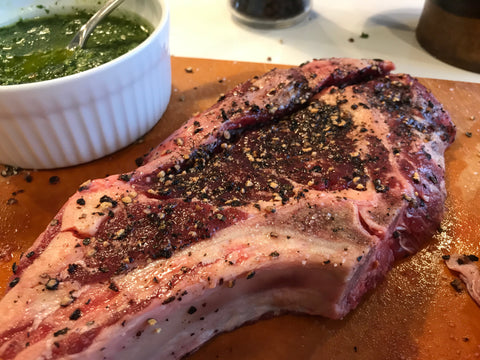When asked how to the cook the perfect steak pan vs grill is the age old question? Both methods including others (sous-vide) can result in perfectly cooked steaks, so ultimately its a matter of what you are most comfortable with and what tools you have available. Here's how you can ensure you'll wow your guests taste buds no matter what cut of grass-fed steak you are cooking.
Preparing your Steak
- If frozen make sure your steak is thawed properly (see thawing instructions), and set it on the counter for about an hour prior to cooking to bring it to room temperature.
- Pat the meat dry with a paper towel or clean rag (wet meat creates steam when it hits a hot pan or grill which won't give you that beautiful crust and texture)
- Season the meat with salt and pepper about 10 minutes before cooking. I like to liberally season with kosher salt and fresh cracked pepper, and remember it's difficult to over season a steak.
- Tip: Seasoning the meat too early can draw moisture out of the meat drying out the steak, so 5-15 minutes before cooking is ideal.

Cooking your Steak in a Pan or Grill
Remember heat is your friend and unless cooked over a direct flame its very difficult to burn a steak. We often find people cooking steaks at too low of temperatures, which can result in dried out steak with a less than desirable look and texture.
Interesting Fact: High-end steak houses will often cook steaks in broilers that reach temperatures of over 1000 degrees Fahrenheit, which is nearly impossible to reach with any home appliances or grills so don't be afraid of using high heat.
Pan or Griddle (Plancha) Method - This is my personal favorite method for cooking steak, because of the even heat distribution and temperature control you have on a range top.
- Use a large cast iron pan/plancha or your heaviest stainless steel frying pan that is oven safe (avoid non-stick pans)
- Preheat your oven to 400 degrees Fahrenheit
- Heat the pan/plancha over high heat for a couple of minutes
- Add the high heat oil of your choice to the hot pan to coat cooking surface in a thin layer (grape seed oil, lard, tallow, or other high heat oil that doesn't have a strong flavor works best. Avoid butter and olive oil as it can burn easily at high heat)
- Heat oil until its just about to smoke or even as it first begins to smoke and make sure the oil is evenly distributed in the pan.
- Gently place your steak(s) on the pan/plancha and keep that heat on high. The meat should sizzle and crackle when it hits the pan and continue to sizzle as you cook it.
- Depending on thickness and preferred meat temperature you'll sear in the pan from 90 seconds to 4 minutes per side.
- When its time to flip I like to use tongs to flip the steak versus a fork or spatula. I also swirl the pan to re-coat the pan surface before I put the uncooked side of the meat down in the pan.
- Tip: Don't crowd the steaks in the pan, so cook in batches if necessary to avoid the meat touching in the pan.
- After you've seared the meat on both sides place the meat in the pan/plancha you used for searing into the preheated oven for 3-8 minutes depending on the thickness and your desired temperature.
- Check the meat temperature periodically to ensure you don't over cook. (Steak Finger Temperature Test). I avoid using a meat thermometer as it punctures the meat and releases the juices, but if you like to know the meat temperature in degrees use a meat thermometer based on the following guideline.
- Tip: Remember you will get some residual cooking after you remove the steak from the oven, so I remove from the oven when its one temperature below where I want to serve it. Ex: remove from oven when rare to rare plus if you want to serve at medium rare.
Grill Method - This method has many variables giving it great benefits, but grilling can have its pitfalls as well. My personal preference is to grill over hardwood lump charcoal, but you can use gas grills effectively as well.
- Get your grill hot (500+ degrees). Cheap gas grills struggle to get this hot and hold the heat, so its worth investing in higher end equipment. The trusty old Weber can get hot especially when using hardwood lump charcoal (avoid charcoal briquets unless you like the taste of chemicals), but something like the Green Egg is even better because you can easily achieve and hold temperatures over 700 degrees.
- Even when grilling I like to use a pan or plancha to keep the cooking surface temperature even and to avoid flame ups as the fats render from the steak.
- Tip: Cast iron is best as most stainless pans cannot stand up to the heat of a grill.
- When using a pan or plancha on the grill add the high heat oil of your choice to the hot pan to coat cooking surface in a thin layer (grape seed oil, lard, tallow, or other high heat oil that doesn't have a strong flavor works best. Avoid butter and olive oil as it can burn easily at high heat)
- Heat oil until its just about to smoke or even as it first begins to smoke and make sure the oil is evenly distributed in the pan. Be very careful as the oil can get to temp very quickly on the grill, and avoid oil spills on the flames or charcoals as that can result in charred eyebrows or worse.
- Gently place your steak(s) on the pan/plancha and keep that heat on high. The meat should sizzle and crackle when it hits the pan and continue to sizzle as you cook it.
- If cooking directly on the grill grate place the steaks at 10 o clock and close the lid to reduce the chance of flame ups. Half way through cooking the first side rotate the steaks to 2 o clock and close the lid which will give you that beautiful cross-hatch pattern.
- Repeat above steps on other side.
- Depending on temperature of the grill, thickness of the steaks and preferred meat temperature you'll cook on the grill from 2-5 minutes per side.
- Tip: When cooking directly on the grill grate know your grills temperature zones as its rare to have even heat distribution. This will help prevent from cooking your steaks unevenly.
- After you've seared the meat on both sides you can turn off your gas grill and finish the cooking process on the grill or find a cool zone on a charcoal grill to to finish cooking (be careful as its easy to overcook). The other option is to place the meat in a preheated pan and place into a preheated 400 degree oven for 3-8 minutes depending on the thickness and your desired temperature.
- Check the meat temperature periodically to ensure you don't over cook. (Steak Finger Temperature Test). I avoid using a meat thermometer as it punctures the meat and releases the juices, but if you like to know the meat temperature in degrees use a meat thermometer based on the following guideline.
- Tip: Remember you will get some residual cooking after you remove the steak from the grill or oven so I remove it to rest when its one temperature below where I want to serve it. Ex: remove from oven or grill when rare to rare plus if you want to serve at medium rare.
Finishing your Steaks
- Rest, Rest, Rest. Remove the meat from the pan/plancha or grill and place on a cutting board or plate and let it rest for 5-10 minutes before serving whole or slicing.
- Tip: Sprinkle with a high quality finishing salt (Himalayan or Sea Salt) just before serving to help the flavors pop. My favorites are Jacobsen Sea Salt and Pink Himalayan Salt. You can also put a slice of butter on top the steak as it rests to enhance the flavor.
For more information on cooking the perfect steak see How to Cook The Perfect Steak, by BBC Good Food, which is a great resource.
Find similar articles
Beef

